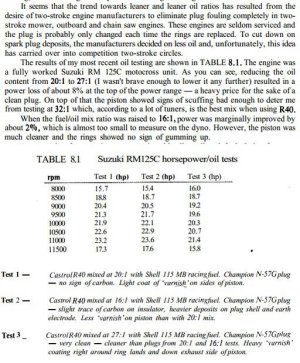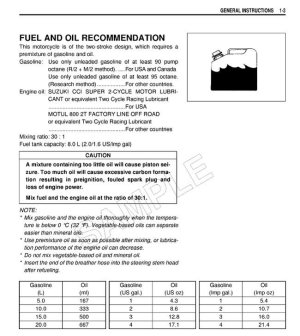motopsycho87
New member
Ok, leading on from my Mod's post, just curious as to your recommended 2-stroke ratios, and the reasoning behind them. I am not trying to cause an argument, just trying to share information and do what's best for my bike, if there is substantial evidence proving me incorrect, I WILL CHANGE MY MIND!
I use 32:1 semi-synthetic, why?
http://www.bridgestonemotorcycle.com/documents/oilpremix6.pdf - Gordon Jennings
http://www.klemmvintage.com/oils.htm - Vintage 2 stroke racing folks, claiming more is better
http://www.2strokeheads.com/OIL-TECH.htm - Claims mineral is better
http://www.dansmc.com/2stroke_oil.htm - Claims more is better
http://www.challengers101.com/EngineOils.html - Claims mineral / semi leaves better film
http://www.wdarc.org/articles_files/2 stroke Oil Test.pdf - Numerous oils tested at recommended ratios on RC engines.
http://ffv8.com/2-stroke-oils.html - Racing engines, more is better.
http://forum.dirtrider.com/discussion/7169620/spooge-101- - MX More is better
http://www.maximausa.com/tech-tips/oil-migration.php - 2 stroke oil mitigation testing
Attached is an excerpt from A Graham Bell's 2 stroke tuning.
I use 32:1 semi-synthetic, why?
http://www.bridgestonemotorcycle.com/documents/oilpremix6.pdf - Gordon Jennings
http://www.klemmvintage.com/oils.htm - Vintage 2 stroke racing folks, claiming more is better
http://www.2strokeheads.com/OIL-TECH.htm - Claims mineral is better
http://www.dansmc.com/2stroke_oil.htm - Claims more is better
http://www.challengers101.com/EngineOils.html - Claims mineral / semi leaves better film
http://www.wdarc.org/articles_files/2 stroke Oil Test.pdf - Numerous oils tested at recommended ratios on RC engines.
http://ffv8.com/2-stroke-oils.html - Racing engines, more is better.
http://forum.dirtrider.com/discussion/7169620/spooge-101- - MX More is better
http://www.maximausa.com/tech-tips/oil-migration.php - 2 stroke oil mitigation testing
Attached is an excerpt from A Graham Bell's 2 stroke tuning.


